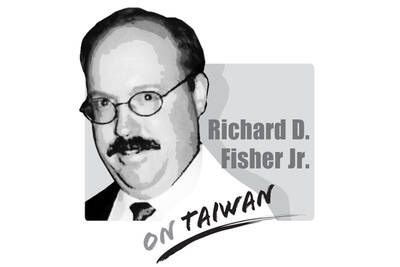Chinese President Xi Jinping (習近平) early last month visited a rare earths company in Jiangxi Province. The visit caused speculation that China might reduce its supply of rare earths to the US as a countermeasure in the trade dispute between the two countries.
After several decades of hard work, China is the global leader in mining, processing, separating and purifying rare earths, and has built a complete rare earth industry chain.
China’s output of rare earths reached 120,000 tonnes last year, much higher than Australia’s 20,000 tonnes in second place and the US’ 15,000 tonnes in third, US Geological Survey data showed.
Chinese output accounted for 70 percent of the global output of 170,000 tonnes.
The US last year imported 18,000 tonnes of rare earths, including rare earth compounds. Eighty percent came from China, but that accounted for only 4 percent of total Chinese output. Part of the reason is that most US manufacturers that need rare earth metals relocated their factories to China after 2010.
In 2010 and 2011, China-Japan relations deteriorated due to disputes over the Diaoyutai Islands (釣魚台), known as the Senkaku Islands in Japan. This led to Chinese restrictions on rare earth exports to Japan and Japanese businesses being forced to turn to Australia and develop alternative techniques.
In June 2012, the Agency for Natural Resources and Energy under the Japanese Ministry of Economy, Trade and Industry issued a resource security strategy, asking government agencies dealing with countries with critical resources such as rare earths to adopt comprehensive complementary measures to ensure a stable supply.
As a result, other countries have attached great importance to the security of critical resources such as rare earths.
The US in 1946 passed the Strategic and Critical Materials Stockpiling Act, requiring the federal government to stockpile certain kinds of strategic and critical materials, and encouraging protection and development of domestic material sources.
Faced with the threat posed by China’s rare earth production advantage, US President Donald Trump in December 2017 signed Executive Order No. 13,817.
It instructs federal agencies to create a list of critical minerals in the hope of reducing reliance on them and to boost domestic supply.
There are large global reserves of rare earths, but thanks to its world-leading mining and separation techniques, China uses rare earths as a bargaining chip in diplomatic, economic and trade disputes. This has forced the US, Japan and the EU to respond with legislation.
As it takes time and effort to build a rare earth industry chain, a Chinese ban on rare earth exports is likely to put pressure on the US high-tech and defense industries in the short term, and it could harm industrialized countries around the world.
Taiwan imports 3,000 tonnes of rare earths yearly, playing no role in the global rare earth industry chain. Some Taiwanese businesses last year established the Taiwan Rare Earths and Rare Resources Industry Alliance to build a domestic rare earth industry supply chain.
This shows that local companies are alert to the need for a secure supply of critical resources.
As the trade dispute escalates, the government should think ahead, and work with industry and academia to evaluate critical resource supply risks and draw up an appropriate strategy for recycling and stockpiling such resources.
Young Chea-yuan is a professor at Chinese Culture University’s Department of Natural Resources.
Translated by Eddy Chang

This should be the year in which the democracies, especially those in East Asia, lose their fear of the Chinese Communist Party’s (CCP) “one China principle” plus its nuclear “Cognitive Warfare” coercion strategies, all designed to achieve hegemony without fighting. For 2025, stoking regional and global fear was a major goal for the CCP and its People’s Liberation Army (PLA), following on Mao Zedong’s (毛澤東) Little Red Book admonition, “We must be ruthless to our enemies; we must overpower and annihilate them.” But on Dec. 17, 2025, the Trump Administration demonstrated direct defiance of CCP terror with its record US$11.1 billion arms
In 2009, Taiwan Semiconductor Manufacturing Co (TSMC) made a welcome move to offer in-house contracts to all outsourced employees. It was a step forward for labor relations and the enterprise facing long-standing issues around outsourcing. TSMC founder Morris Chang (張忠謀) once said: “Anything that goes against basic values and principles must be reformed regardless of the cost — on this, there can be no compromise.” The quote is a testament to a core belief of the company’s culture: Injustices must be faced head-on and set right. If TSMC can be clear on its convictions, then should the Ministry of Education
China’s recent aggressive military posture around Taiwan simply reflects the truth that China is a millennium behind, as Kobe City Councilor Norihiro Uehata has commented. While democratic countries work for peace, prosperity and progress, authoritarian countries such as Russia and China only care about territorial expansion, superpower status and world dominance, while their people suffer. Two millennia ago, the ancient Chinese philosopher Mencius (孟子) would have advised Chinese President Xi Jinping (習近平) that “people are the most important, state is lesser, and the ruler is the least important.” In fact, the reverse order is causing the great depression in China right now,
We are used to hearing that whenever something happens, it means Taiwan is about to fall to China. Chinese President Xi Jinping (習近平) cannot change the color of his socks without China experts claiming it means an invasion is imminent. So, it is no surprise that what happened in Venezuela over the weekend triggered the knee-jerk reaction of saying that Taiwan is next. That is not an opinion on whether US President Donald Trump was right to remove Venezuelan President Nicolas Maduro the way he did or if it is good for Venezuela and the world. There are other, more qualified